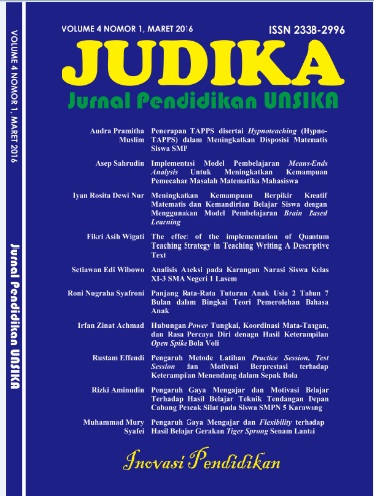THE EFFECT OF THE IMPLEMENTATION OF QUANTUM TEACHING STRATEGY IN TEACHING WRITING A DESCRIPTIVE TEXT
DOI:
https://doi.org/10.35706/judika.v4i1.235Abstract
The research was aimed to know the effect of Quantum Teaching Strategy (QTS) on the student’s performance of English Writing Skill in comparison to Conventional Teaching Strategy (CTS). The quantitative research was to measure the effects of QTS on the Writing performance. The data was taken from an experimental research, involving 30 students in UNSIKA (Singaperbangsa Karawang University) in the English Education program. The 3rdsemester students were randomly selected. 15 students run learning activity with quantum learning method and 15 students studied in control group. The experimental group got particular treatments related to quantum learning method. The treatment for the experimental group was practicing writing through experiencing the 5 steps of The control group was taught in conventional teaching strategy. Both groups pretest and post test to identify their performance on the writing skill improvement. The measurement for both groups was conducted at the same test. In term of quantitative approach, quasi experiment design was used to describe the different result of experimental group and control group. T-test was used to analyze the data to measure the effect of quantum teaching strategy in comparison to Conventional Teaching Strategy (CTS). By means of The T Test, the finding showed that QTS affected the performance of the students’ Writing skill. It is recommended for English Teacher to use QTS as alternative to improve quality of teaching.
Keywords: Quantum Teaching Strategy, WritingDownloads
References
Arnie, A. and Nisa, C. (2002). Quantum Learning Meningkatkan Hasil Belajar: Penelitian dalam Rangka Lomba Karya Ilmiah Remaja. Jakarta: Depdiknas
Brown, H. D. (2004). Language Assessment, Principles and Classroom Practices. New York: Pearson Education, Inc.
__________. (2001). Teaching by Principles. An Interactive Approach to Language Pedagogy. Englewood Cliffs: Prentice Hall.
Byrne, D. (1988). Teaching writing skills. Singapore: Longman.
Carnell, E. (2005). Understanding and enriching young people learning: issues, complexities and challenges. Improving School.
DePorter, B. R. (2002). Quantum Learning. (translated by Ary Nilandari). Bandung. Kaifa
DePorter, B. R, & Nourie. (1999). Quantum Teaching: Orchestrating Student Success. Boston: Allyin and Bacon
Evelyn, H., and Lazarton, A. (1991). The Research Manual: Design and Statistics for applied Linguistics. Massachussets: Heinle& Heinle Publisher
Frankel, J. R., and Wallen, N. E. (1996). How To Design And Evaluate Research in Education. New York: McGraw-Hill.inc
Greenville, K. (2001). Writing from start to finish: a six steps guide. South Australia: Griffin Press.
Harmer, J. (2007). How to Teach English. China: Pearson Education Limited.
_______. (2002). The Practical English as a Foreign Language Teaching. Malaysia: Pearson Education Limited.
Hughes, A. (1989). Testing For language Teachers. Melbourne: Cambridge University Press.
Oshima, A., & Hogue, A. (2007). Introduction to Academic writing: third edition. USA: Pearson Education. Inc.
____________________. (2006). Writing Academic English: fourth edition. USA: Pearson Education, Inc.
____________________. (1999). Writing Academic English: third edition USA: Pearson Education, Inc.
Thornbury, S. (2005). How to Teach Writing. Malaysia; Longman.
www.harianekonomineraca.com



